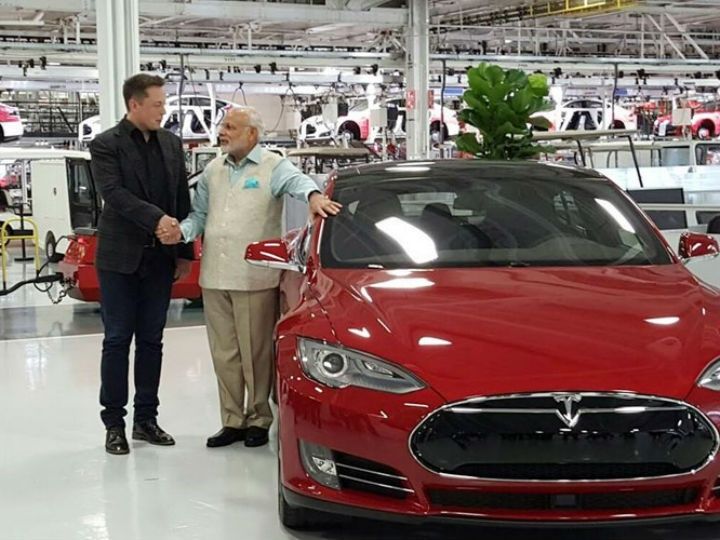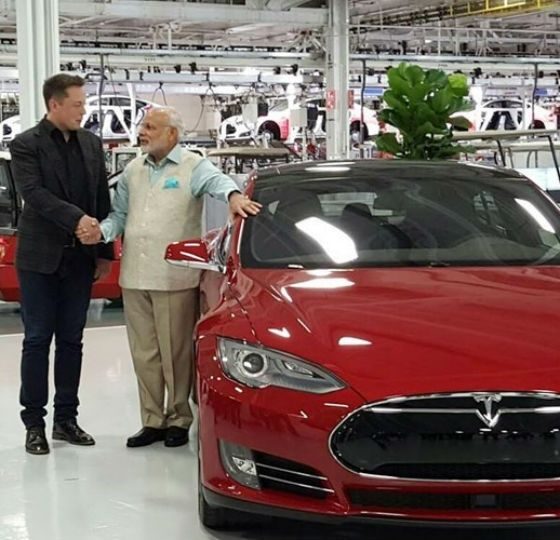

News
Opinion: Tesla and India is the right thing at the wrong time
Tesla and India will not be working together any time soon, as new reports now indicate that Tesla has pulled its team responsible for entrance into the Indian market to other regions. Tesla and India might be a powerful one-two punch in the future, but in 2022, the two are just the right thing at the wrong time.
When Tesla first started making moves toward entering the Indian automotive market, there was a lot of excitement. The unbelievable potential of a partnership between the world’s leading electric car company and a government that primarily focuses on domestic manufacturing efforts, mainly due to the Make in India initiative, had people buzzing. However, there were still hoops to jump through. Any person with any sort of knowledge about India and cars knows that it is an expensive place to own one, especially if it was not built there. Getting cars from outside of India into the country doubles the cost of the vehicle on most occasions due to import duties. This is when Tesla started to realize how difficult this whole process might be.
Tesla places its India entry on hold after failing to secure lower import taxes: report
In routine negotiations, even with companies and governments, there is always a brief standoff period to see who will budge first. The hypothetical game of chicken can be magnified when dealing with two large entities, but eventually, something happens where someone makes a move, and things start to come together. I thought a great, recent, and relevant example of this would be the Elon Musk-Twitter buyout, where, as the board of the platform mozied over the Tesla CEO’s offer, new developments were few and far between, as expected. Nothing was going to move forward until someone budged.
The issue is that sometimes people choose not to budge because their needs in a particular deal are non-negotiable. When the needs of both sides are non-negotiable, it complicates the entire ordeal, and this is what made the Tesla-India deal stagnate: Two large entities that had specific requirements to make something happen. Neither was asking for a small thing, so it is not necessarily unreasonable that Tesla put its plans for India on hold.
Tesla needed to test demand for its cars. It would only be able to do this by building them in Fremont, California, Austin, Texas, Brandenburg, Germany, or Shanghai, China, and then shipping them to India. The problem with this system was it would not be an accurate representation of what Tesla might be able to sell in the market, as the vehicles would still be subjected to massive import duties that would double the cost of the car in some cases. Only a small percentage of the population would be able to afford that, and with very little EV infrastructure in India, it made the company’s products even less attractive. Tesla was effectively stuck between a rock and a hard place because it had an interest in building and selling cars in India, it just needed to confirm that the people of India wanted to buy the cars. Indian government officials rarely offered commentary that was indicative of a willingness to budge.
India wanted Tesla to commit to building a new Gigafactory in their country, which would align with the government’s focus on domestic manufacturing efforts and would likely give officials enough to pull back import duties for Tesla. However, Tesla could not commit to this: there was no indication that demand would be high enough to justify an entire factory, and Tesla was not sure it would be able to export vehicles from the Indian factory to other countries. Given the economic situations across the world during the past two years due to the COVID-19 pandemic, neither entity would be able to budge from their needs.
India and Tesla were the right thing, just at the wrong time. Given the extreme demands that both Tesla and Indian officials needed, it was best to not beat a dead horse any longer and move on from the potential partnership, at least temporarily. Tesla does have a lot of potential in India, but it cannot justify purchasing massive land plots for a new facility, it cannot justify spending millions more on showrooms and service centers, and it can not adequately test the want for its vehicles with massive import taxes trailing behind every car sent to the market.
Try again in a few years, hopefully.
I’d love to hear from you! If you have any comments, concerns, or questions, please email me at joey@teslarati.com. You can also reach me on Twitter @KlenderJoey, or if you have news tips, you can email us at tips@teslarati.com.

News
Tesla FSD fleet is nearing 7 billion total miles, including 2.5 billion city miles
As can be seen on Tesla’s official FSD webpage, vehicles equipped with the system have now navigated over 6.99 billion miles.

Tesla’s Full Self-Driving (Supervised) fleet is closing in on almost 7 billion total miles driven, as per data posted by the company on its official FSD webpage.
These figures hint at the massive scale of data fueling Tesla’s rapid FSD improvements, which have been quite notable as of late.
FSD mileage milestones
As can be seen on Tesla’s official FSD webpage, vehicles equipped with the system have now navigated over 6.99 billion miles. Tesla owner and avid FSD tester Whole Mars Catalog also shared a screenshot indicating that from the nearly 7 billion miles traveled by the FSD fleet, more than 2.5 billion miles were driven inside cities.
City miles are particularly valuable for complex urban scenarios like unprotected turns, pedestrian interactions, and traffic lights. This is also the difference-maker for FSD, as only complex solutions, such as Waymo’s self-driving taxis, operate similarly on inner-city streets. And even then, incidents such as the San Francisco blackouts have proven challenging for sensor-rich vehicles like Waymos.
Tesla’s data edge
Tesla has a number of advantages in the autonomous vehicle sector, one of which is the size of its fleet and the number of vehicles training FSD on real-world roads. Tesla’s nearly 7 billion FSD miles then allow the company to roll out updates that make its vehicles behave like they are being driven by experienced drivers, even if they are operating on their own.
So notable are Tesla’s improvements to FSD that NVIDIA Director of Robotics Jim Fan, after experiencing FSD v14, noted that the system is the first AI that passes what he described as a “Physical Turing Test.”
“Despite knowing exactly how robot learning works, I still find it magical watching the steering wheel turn by itself. First it feels surreal, next it becomes routine. Then, like the smartphone, taking it away actively hurts. This is how humanity gets rewired and glued to god-like technologies,” Fan wrote in a post on X.
News
Tesla starts showing how FSD will change lives in Europe
Local officials tested the system on narrow country roads and were impressed by FSD’s smooth, human-like driving, with some calling the service a game-changer for everyday life in areas that are far from urban centers.

Tesla has launched Europe’s first public shuttle service using Full Self-Driving (Supervised) in the rural Eifelkreis Bitburg-Prüm region of Germany, demonstrating how the technology can restore independence and mobility for people who struggle with limited transport options.
Local officials tested the system on narrow country roads and were impressed by FSD’s smooth, human-like driving, with some calling the service a game-changer for everyday life in areas that are far from urban centers.
Officials see real impact on rural residents
Arzfeld Mayor Johannes Kuhl and District Administrator Andreas Kruppert personally tested the Tesla shuttle service. This allowed them to see just how well FSD navigated winding lanes and rural roads confidently. Kruppert said, “Autonomous driving sounds like science fiction to many, but we simply see here that it works totally well in rural regions too.” Kuhl, for his part, also noted that FSD “feels like a very experienced driver.”
The pilot complements the area’s “Citizen Bus” program, which provides on-demand rides for elderly residents who can no longer drive themselves. Tesla Europe shared a video of a demonstration of the service, highlighting how FSD gives people their freedom back, even in places where public transport is not as prevalent.
What the Ministry for Economic Affairs and Transport says
Rhineland-Palatinate’s Minister Daniela Schmitt supported the project, praising the collaboration that made this “first of its kind in Europe” possible. As per the ministry, the rural rollout for the service shows FSD’s potential beyond major cities, and it delivers tangible benefits like grocery runs, doctor visits, and social connections for isolated residents.
“Reliable and flexible mobility is especially vital in rural areas. With the launch of a shuttle service using self-driving vehicles (FSD supervised) by Tesla in the Eifelkreis Bitburg-Prüm, an innovative pilot project is now getting underway that complements local community bus services. It is the first project of its kind in Europe.
“The result is a real gain for rural mobility: greater accessibility, more flexibility and tangible benefits for everyday life. A strong signal for innovation, cooperation and future-oriented mobility beyond urban centers,” the ministry wrote in a LinkedIn post.
News
Tesla China quietly posts Robotaxi-related job listing
Tesla China is currently seeking a Low Voltage Electrical Engineer to work on circuit board design for the company’s autonomous vehicles.

Tesla has posted a new job listing in Shanghai explicitly tied to its Robotaxi program, fueling speculation that the company is preparing to launch its dedicated autonomous ride-hailing service in China.
As noted in the listing, Tesla China is currently seeking a Low Voltage Electrical Engineer to work on circuit board design for the company’s autonomous vehicles.
Robotaxi-specific role
The listing, which was shared on social media platform X by industry watcher @tslaming, suggested that Tesla China is looking to fill the role urgently. The job listing itself specifically mentions that the person hired for the role will be working on the Low Voltage Hardware team, which would design the circuit boards that would serve as the nervous system of the Robotaxi.
Key tasks for the role, as indicated in the job listing, include collaboration with PCB layout, firmware, mechanical, program management, and validation teams, among other responsibilities. The role is based in Shanghai.
China Robotaxi launch
China represents a massive potential market for robotaxis, with its dense urban centers and supportive policies in select cities. Tesla has limited permission to roll out FSD in the country, though despite this, its vehicles have been hailed as among the best in the market when it comes to autonomous features. So far, at least, it appears that China supports Tesla’s FSD and Robotaxi rollout.
This was hinted at in November, when Tesla brought the Cybercab to the 8th China International Import Expo (CIIE) in Shanghai, marking the first time that the autonomous two-seater was brought to the Asia-Pacific region. The vehicle, despite not having a release date in China, received a significant amount of interest among the event’s attendees.








